Barbecue
Barbecue or barbeque (informally, BBQ; in Australia barbie, in South Africa braai) is a cooking method, a cooking device, a style of food, and a name for a meal or gathering at which this style of food is cooked and served.
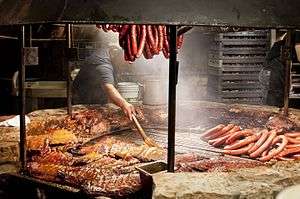
A barbecue can refer to the cooking method itself, the meat cooked this way, or to a type of social event featuring this type of cooking. Barbecuing is usually done outdoors by smoking meat over wood or charcoal. Restaurant barbecue may be cooked in large, specially-designed brick or metal ovens. Barbecue is practiced in many countries and there are numerous regional variations.
Barbecuing techniques include smoking, roasting, and grilling. The technique for which it is named involves cooking using smoke at low temperatures and long cooking times (several hours). Grilling is done over direct, dry heat, usually over a hot fire for a few minutes.
Etymology and history
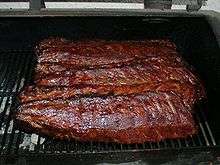
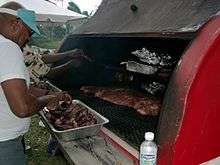
The English word "barbecue" and its cognates in other languages come from the Spanish word barbacoa. Etymologists believe this to be derived from barabicu found in the language of the Arawak people of the Caribbean and the Timucua people of Florida;[1] it has entered some European languages in the form of the aforementioned barbacoa. The Oxford English Dictionary (OED) traces the word to Haiti and translates it as a "framework of sticks set upon posts".[2] Gonzalo Fernández De Oviedo y Valdés, a Spanish explorer, was the first to use the word "barbecoa" in print in Spain in 1526 in the Diccionario de la Lengua Española (2nd Edition) of the Real Academia Española. After Columbus landed in the Americas in 1492, the Spaniards apparently found Taíno roasting meat over a grill consisting of a wooden framework resting on sticks above a fire. The flames and smoke rose and enveloped the meat, giving it a certain flavor.[3]
Traditional barbacoa involves digging a hole in the ground and placing some meat—usually a whole lamb—above a pot so the juices can be used to make a broth. It is then covered with maguey leaves and coal, and set alight. The cooking process takes a few hours. Olaudah Equiano, an African abolitionist, described this method of roasting alligators among the Mosquito People (Miskito people) on his journeys to Cabo Gracias a Dios in his narrative The Interesting Narrative of the Life of Olaudah Equiano.[4]
Linguists have suggested the word was loaned successively into Spanish, then Portuguese, French, and English. In the form barbacado the word was used in English in 1648 by the supposed Beauchamp Plantagenet in the tract A description of the province of New Albion: "the Indians in stead of salt doe barbecado or dry and smoak fish".[5] According to the OED, the first recorded use in modern form was in 1661, in Edmund Hickeringill's Jamaica Viewed: "Some are slain, And their flesh forthwith Barbacu'd and eat";[2] it also appears in 1672 in the writings of John Lederer following his travels in the North American southeast in 1669–70.[6] First known use as a noun was in 1697 by the English buccaneer William Dampier. In his New Voyage Round the World, Dampier wrote, " ... and lay there all night, upon our Borbecu's, or frames of Sticks, raised about 3 foot from the Ground".[7]
Samuel Johnson's 1756 dictionary gave the following definitions:[8]
- "To Barbecue – a term for dressing a whole hog" (attestation to Pope)
- "Barbecue – a hog dressed whole"
While the standard modern English spelling of the word is barbecue, variations including barbeque and truncations such as bar-b-q or BBQ may also be found.[9] The spelling barbeque is given in Merriam-Webster and the Oxford Dictionaries as a variant.[10][11] In the southeastern United States, the word barbecue is used predominantly as a noun referring to roast pork, while in the southwestern states cuts of beef are often cooked.[12]
Associations
Because the word barbecue came from native groups, Europeans gave it "savage connotations."[13] This association with barbarians and "savages" is strengthened by Edmund Hickeringill's work Jamaica Viewed: with All the Ports, Harbours, and their Several Soundings, Towns, and Settlements through its descriptions of cannibalism. However, according to Andrew Warnes, there is very little proof that Hickeringill's tale of cannibalism in the Caribbean is even remotely true.[14] Another notable false depiction of cannibalistic barbecues appears in Theodor de Bry's Great Voyages, which in Warnes's eyes, "present smoke cookery as a custom quintessential to an underlying savagery ... that everywhere contains within it a potential for cannibalistic violence."[15] Today, those in the U.S. associate barbecue with "classic Americana."[16]
Styles

In American English usage, grilling refers to a fast process over high heat while barbecuing refers to a slow process using indirect heat or hot smoke, similar to some forms of roasting. In a typical U.S. home grill, food is cooked on a grate directly over hot charcoal, while in a U.S. barbecue the coals are dispersed to the sides or at a significant distance from the grate. In British usage, barbecuing refers to a fast cooking process done directly over high heat, while grilling refers to cooking under a source of direct, moderate-to-high heat—known in the United States as broiling. Its South American versions are the southern Brazilian churrasco and the Argentine asado.[17]
United States
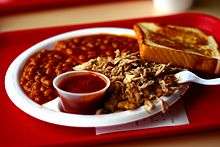

According to estimates, prior to the American Civil War, Southerners ate around five pounds of pork for every pound of beef they consumed.[18] Because of the effort to capture and cook these wild hogs, pig slaughtering became a time for celebration and the neighborhood would be invited to share in the largesse. In Louisiana Creole and Cajun culture, these feasts are called boucheries or "pig pickin's". The traditional Southern barbecue grew out of these gatherings.[19]
Each Southern locale has its own variety of barbecue, particularly sauces. South Carolina is the only state that traditionally includes all four recognized barbecue sauces, including mustard-based, vinegar-based, and light and heavy tomato-based sauces. North Carolina sauces vary by region; eastern North Carolina uses a vinegar-based sauce, the center of the state uses Lexington-style barbecue, with a combination of ketchup and vinegar as their base, and western North Carolina uses a heavier ketchup base. Memphis barbecue is best known for tomato- and vinegar-based sauces. In some Memphis establishments and in Kentucky, meat is rubbed with dry seasoning (dry rubs) and smoked over hickory wood without sauce. The finished barbecue is then served with barbecue sauce on the side.[20]
The barbecue of Alabama, Georgia, and Tennessee is almost always pork, often served with a sweet tomato-based sauce. Several regional variations exist. Alabama is also known for its distinctive white sauce—a mayonnaise- and vinegar-based sauce originating in northern Alabama, used predominantly on chicken and pork. A popular item in North Carolina and Memphis is the pulled pork sandwich served on a bun and often topped with coleslaw. Pulled pork is prepared by shredding the pork after it has been barbecued.[21]
Kansas City-style barbecue is characterized by its use of different types of meat, including pulled pork, pork ribs, burnt ends, smoked sausage, beef brisket, beef ribs, smoked/grilled chicken, smoked turkey, and sometimes fish—a variety attributable to Kansas City's history as a center for meat packing. Hickory is the primary wood used for smoking in Kansas City, while the sauces are typically tomato based with sweet, spicy, and tangy flavors.
Pit beef prevails in Maryland and is often enjoyed at large outdoor "bull roasts", which are commonly fundraising events for clubs and associations. Maryland-style pit-beef is not the product of barbecue cookery in the strictest sense; the meat is not smoked but grilled over a high heat. The meat is typically served rare with a strong horseradish sauce as the preferred condiment.[22]
The state of Kentucky, particularly Western Kentucky, is unusual in its barbecue cooking; the preferred meat is mutton.[23] This kind of mutton barbecue is often used in communal events in Kentucky, such as political rallies, county fairs, and church fund-raising events.[24]
Tradition

In the United States
Barbecue remains one of the most traditional foods in the United States. While many festive foods, such as roasted turkey or ham, are usually served on particular days or holidays, barbecue can be served on any day. Barbecue is often served on the Fourth of July, however, it is not only confined to that day. Barbecues tend to bring people together and serve as a bonding experience at any time of the year. It brings people back to their roots, providing a cooking experience that is often an escape from civilization and closer to nature.[25] Barbecues are traditionally held outside. They could be small informal gatherings with a few people in a backyard or a formal event that could last all day, typically held for larger numbers of people. Barbecue has been a tradition in the United States beginning with Native Americans. As author Andrew Warnes states, "its mythology of savagery and freedom, of pleasure, masculinity and strength" is part of what makes barbecues so popular to date.[25] By the 19th century barbecues became one of the main forms of United States public celebration, especially in celebration of 4 July.[26]
As barbecues continued to be held through the times of U.S. expansion the traditions began to migrate with the people. Today, barbecues held in different regions of the country vary in cuisine but the cuisines all hold the same concept of cooking outside and over a fire.[27] Barbecues today have taken on new meaning yet again with the emergence of competitive barbecue. Competitive barbecue competitions are held throughout the country in which people will compete by cooking barbecue and having it judged by the events judges. The constraints of what one may barbecue and the qualities that are judged vary by competition. Usually competitions are held in big open areas where spectators will be admitted as well and barbecue is served to all.[28][29]
Techniques
Barbecuing encompasses multiple types of cooking techniques. The original technique is cooking using smoke at low temperatures—usually around 240–280 °F or 115–145 °C—and significantly longer cooking times (several hours), known as smoking.
Grilling is done over direct, dry heat, usually over a hot fire over 500 °F (260 °C) for a few minutes. Grilling may be done over wood, charcoal, gas, or electricity. The time difference between smoking and grilling is because of the temperature difference; at low temperatures used for smoking, meat takes several hours to reach the desired internal temperature.[30][31]
Smoking
Smoking is the process of flavoring, cooking, and/or preserving food by exposing it to smoke from burning or smoldering material, most often wood. Meat and fish are the most common smoked foods, though cheeses, vegetables, nuts, and ingredients used to make beverages such as beer or smoked beer are also smoked.[32][33]
Grilling
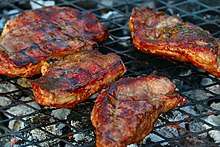
Grilling is a form of cooking that involves a dry heat applied to the food, either from above or below. Grilling is an effective technique in order to cook meat or vegetables quickly since it involves a significant amount of direct, radiant heat. There are many methods of grilling, which involve a type of braising or roasting. This is one of the least common techniques when cooking classic barbecue foods.[34]
The words "barbecue" and "grilling" are often used interchangeably, although food experts argue that barbecue is a type of grilling, and that grilling involves the use of a higher level of heat to sear the food, while barbecuing is a slower process over a low heat.[35]
Other uses
The term barbecue is also used to designate a flavor added to food items, the most prominent of which are potato chips.[36]
See also
- Asado – Latin-American dish of beef, sausages, and sometimes other meats, cooked on a grill (parrilla) or an open fire
- Barrel barbecue – Type of barbecue made from a 55-gallon barrel.
- Braai
- Burnt ends
- Carne asada – Dish of grilled and sliced beef
- Char siu
- Churrasco
- Kansas City-style barbecue
- Kebab – Variety of meat dishes originating in the Middle East
- Korean barbecue
- List of barbecue dishes – Wikipedia list article
- List of barbecue restaurants – Wikipedia list article
- List of smoked foods
- Mangal
- Memphis-style barbecue
- Mongolian barbecue – A stir fried dish
- North Carolina barbecue
- Regional variations of barbecue
- Ribfest – Type of food festival that occurs throughout the United States and Canada
- Satay – Indonesian dish of spicy seasoned, skewered and grilled meat, served with a sauce
- Shaokao, Chinese barbecue
- Shashlik
- Spice rub
- St. Louis-style barbecue
- Teppanyaki – Post–World War II style of Japanese cuisine that uses an iron griddle to cook food
- Texas Barbecue – Traditional regional styles of smoked barbecue unique to Texan cuisine
- Yakiniku
References
- Hale, C. Clark (2000). The Great American Barbecue and Grilling Manual. McComb, MS: Abacus Pub. Co. ISBN 0936171022.
- "Oxford Dictionary". Old.cbbqa.org. Retrieved 12 December 2015.
- Peters, Philip Dickenson (2003). Caribbean Wow 2.0 (1st ed.). Coral Gables, Fla.: House of Zagada. p. 27. ISBN 9781929970049. Retrieved 12 December 2015.
- Equino, Olaudah (2012). The Interesting Narrative of the Life of Olaudah Equiano. Lanham: Start Publishing LLC. p. 316. ISBN 1625584717. Retrieved 12 December 2015.
- Plantagenet, Beauchamp (1648). "4". A description of the province of New Albion. Retrieved 15 March 2019.
- Lederer, John (1672). The Discoveries of John Lederer. p. 28. Retrieved 12 December 2015.
- Dampier, William. A New Voyage Round the World. Ripol Classic. p. 20. ISBN 1148385150. Retrieved 12 December 2015.
- Johnson, Samuel (1756). A dictionary of the English language. Oxford University. p. 70. Retrieved 12 December 2015.
- "storySouth / southern barbecue BBQ culture and foodways". Storysouth.com. 5 April 2002. Retrieved 6 September 2012.
- "Barbeque". Free Merriam-Webster Dictionary. Retrieved 6 September 2012.
- "Definition of barbecue". Oxford Dictionaries (British & World English). 24 June 2013. Retrieved 24 June 2013.
- "America searches for the perfect barbecue". Newsweek. 103 (19–26). Retrieved 12 December 2015.
- Warnes, Andrew (2008). Savage Barbecue: Race, Culture, and the Invention of America's First Food. University of Georgia Press. p. 24.
- Warnes, Andrew (2008). Savage Barbecue: Race, Culture, and the Invention of America's First Food. University of Georgia Press. p. 32.
- Warnes, Andrew (2008). Savage Barbecue: Race, Culture, and the Invention of America's First Food. University of Georgia Press. p. 36.
- Warnes, Andrew (2008). Savage Barbecue: Race, Culture, and the Invention of America's First Food. University of Georgia Press. p. 3.
- Matthew Bell (18 July 2013). "Gaucho grill: How to cook the Argentinian way | Reviews | Lifestyle". The Independent. Retrieved 12 December 2015.
- Taylor, Joe Gray (1982). Eating, Drinking, and Visiting in the South: An Informal History (Louisiana pbk ed.). Baton Rouge: Louisiana State Univ. Press. p. 27. ISBN 0-8071-1013-2. Retrieved 12 December 2015.
- Geiling, Natasha. "The Evolution of American Barbecue". Smithsonian. Retrieved 7 May 2018.
- "A Year of Barbecue: Kentucky Mutton - Food Republic". Food Republic. 13 March 2012. Retrieved 7 May 2018.
- "What's the secret to making tender, juicy pulled pork?". Food. Retrieved 7 May 2018.
- Raichlen, Steven (28 June 2000). "How to Say Barbecue in Baltimore". New York Times. Baltimore (Md). Retrieved 12 December 2015.
- "Stalking the Barbecued Mutton". The New Yorker. 7 February 1977. Retrieved 12 December 2015.
- "A Year of Barbecue: Kentucky Mutton - Food Republic". Food Republic. 13 March 2012. Retrieved 7 May 2018.
- Warnes, Andrew (2008). Savage Barbecue: Race, Culture, and the Invention of America's First Food. Athens, Georgia: University of Georgia Press. pp. 5–6. ISBN 0820331090.
- Moss, Robert (2010). Barbecue: The History of an American Institution. the University of Alabama Press. ISBN 978-0-8173-1718-8.
- Smith, Merril D. (2013). History of American Cooking. pp. chapter 2: Barbecuing. ISBN 978-0-313-38711-1.
- "Steak Out". Retrieved 11 July 2016.
- "Smoke and mirrors". The Economist. ISSN 0013-0613. Retrieved 11 July 2016.
- McElhiney, Jacqui (24 July 2015). "How to cook meat properly on the barbecue". BBC Good Food. Retrieved 14 April 2016.
- "Barbecue 101". SAVEUR. 17 June 2011. Retrieved 14 April 2016.
- Colby, Chris. "Smoked Beer". Retrieved 19 October 2017.
- McGee p. 767: "Malt whiskies from Scotland's west coast have a unique, smoky flavor that comes from the use of peat fire for drying the malt."
- "Grill vs barbecue – do you know the difference?". Global News. Retrieved 7 May 2018.
- Grinberg, Emanuella (6 July 2015). "The difference between grilling and barbecue". CNN. Retrieved 16 May 2018.
- Hayes, Dayle; Laudan, Rachel (2009). Food and Nutrition/Editorial Advisers, Dayle Hayes, Rachel Laudan. Marshall Cavendish. ISBN 9780761478201.
External links
| Wikibooks Cookbook has a recipe/module on |
| Look up barbecue in Wiktionary, the free dictionary. |
| Wikimedia Commons has media related to Barbecue (cooking technique). |
- . Encyclopædia Britannica. 3 (11th ed.). 1911.
- Barbecue Food Safety (U.S. Dept. of Agriculture)
- The Internet BBQ FAQ
- Barbecue: A History of the World's Oldest Culinary Art Web cast from the Library of Congress

